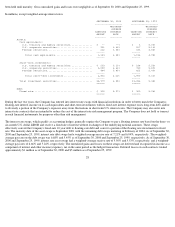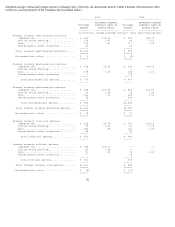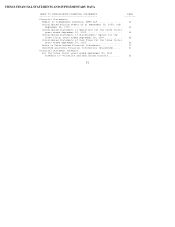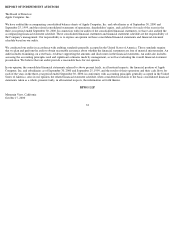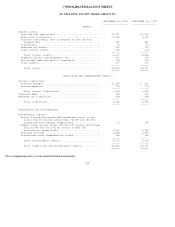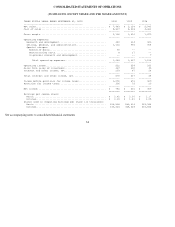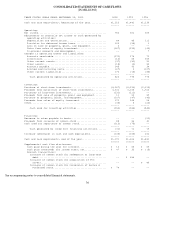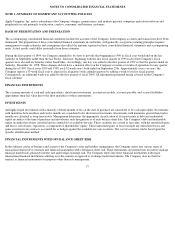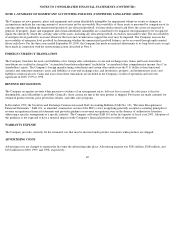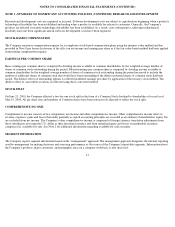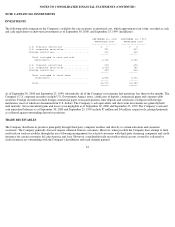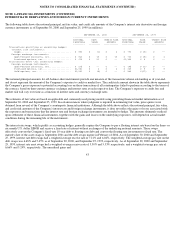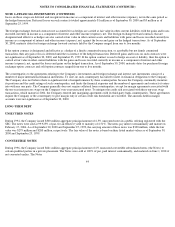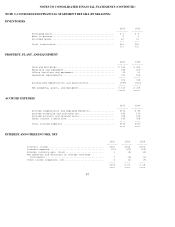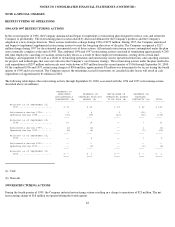Apple 2000 Annual Report Download - page 41
Download and view the complete annual report
Please find page 41 of the 2000 Apple annual report below. You can navigate through the pages in the report by either clicking on the pages listed below, or by using the keyword search tool below to find specific information within the annual report.NOTES TO CONSOLIDATED FINANCIAL STATEMENTS (CONTINUED)
NOTE 1--SUMMARY OF SIGNIFICANT ACCOUNTING POLICIES (CONTINUED)
The Company enters into interest rate derivative transactions, including interest rate swaps, collars, and floors, with financial institutions in
order to better match the Company's floating-rate interest income on its cash equivalents and short-term investments with its fixed-rate interest
expense on its long-term debt, and/or to diversify a portion of the Company's exposure away from fluctuations in short-term U.S. interest rates.
The Company may also enter into interest rate contracts that are intended to reduce the cost of the interest rate risk management program.
The Company enters into foreign exchange forward and option contracts with financial institutions primarily to protect against currency
exchange risks associated with existing assets and liabilities, certain firmly committed transactions, and probable but not firmly committed
transactions. Generally, the Company's practice is to hedge a majority of its existing material foreign exchange transaction exposures.
However, the Company may not hedge certain foreign exchange transaction exposures due to immateriality, prohibitive economic cost of
hedging particular exposures, and availability of appropriate hedging instruments. Foreign exchange forward contracts are carried at fair value
in other current assets and liabilities. The premium costs of purchased foreign exchange option contracts are recorded in other current assets
and amortized over the life of the option.
Probable but not firmly committed transactions comprise sales of the Company's products and purchases of raw material, subassemblies, and
assembled finished goods in currencies other than the functional currency. A majority of these transactions are made through the Company's
subsidiaries in Europe, Asia (particularly Japan), Canada, and Australia. The Company purchases foreign exchange option contracts to hedge
the currency exchange risks associated with these probable but not firmly committed transactions. The Company also sells foreign exchange
option contracts, in order to partially finance the purchase of these foreign exchange option contracts. The term of the Company's foreign
exchange hedging instruments, whether for firmly committed transactions, probable but not firmly committed transactions, or to partially
finance the foreign exchange risk management program currently does not extend beyond six months.
In addition, the Company has entered into foreign exchange forward contracts to hedge certain intercompany loan transactions. These forward
contracts effectively change certain foreign currency denominated debt into U.S. dollar denominated debt, which better matches against the
Company's U.S. dollar denominated cash equivalents and short-term investments.
Interest rate and foreign exchange instruments generally qualify as accounting hedges if their maturity dates are the same as the hedged
transactions and if the hedged transactions meet certain requirements. The Company monitors its interest rate and foreign exchange positions
on a regular basis based on applicable and commonly used pricing models. The correlation between the changes in the fair value of hedging
instruments and the changes in the underlying hedged items is assessed periodically over the life of the hedged instrument. In the event it is
determined a hedge is ineffective, including if and when the hedged transactions no longer exist, the Company recognizes in income the change
in market value of the instrument beginning on the date it was no longer an effective hedge.
Gains and losses on accounting hedges of existing assets or liabilities are generally recorded in income or shareholders' equity against the
losses and gains on the hedged transactions. Gains and losses related to qualifying accounting hedges of firmly committed or probable but not
firmly committed transactions are deferred and recognized in income in the same period as the hedged transactions. Gains and losses on
accounting hedges realized before the settlement date of the related hedged transaction are also generally deferred and recognized in income in
the same period as the hedged transactions.
38


